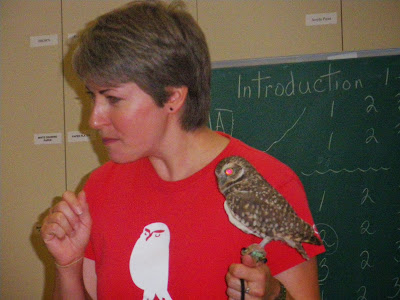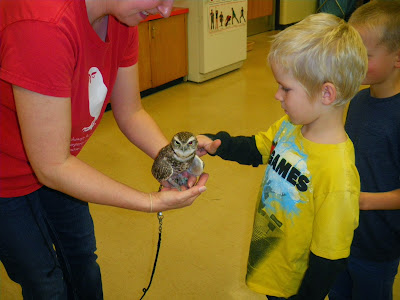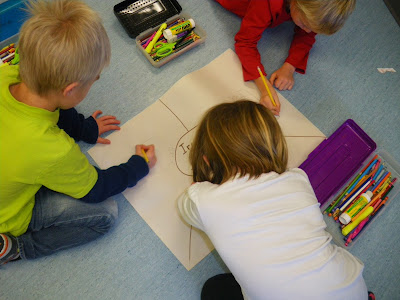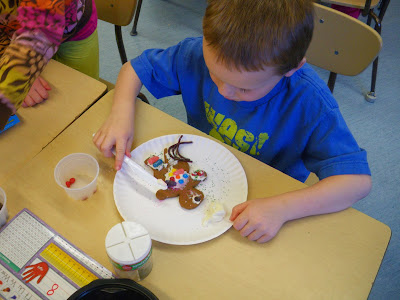A few pictures from our gingerbread cookie decorating experience this afternoon:
Thursday, 19 December 2013
Wednesday, 18 December 2013
Gingerbread, Kilkees and Pulla!
Today we were fortunate to taste some more great food. We had delicious gingerbread cookies, kilkees (kind of like lazy perogies) with a yummy cheese sauce and pulla (sweet bread from Finland spiced with cardamom). Special thanks to Anne's mom for baking the pulla for us to taste and telling us about how children in Finland celebrate Christmas.
Tomorrow we will be decorating our gingerbread cookies!
Tomorrow we will be decorating our gingerbread cookies!
 |
| Math work - using an unsharpened pencil to compare length |
 |
| Learning about special Christmas food in Finland |
 |
| Tasting pulla! |
 |
| Pulla |
 |
| Gingerbread door to our classroom! The gingerbread people are glyphs that we made this afternoon. |
 |
| Art work - fish painted with primary and secondary colours |
 |
| Crazy Cats |
 |
| Students drew cats with different kinds of lines and designs. |
Tuesday, 17 December 2013
Letters from Santa and Crazy Hair and PJ Day!
As Christmas holidays draw near, students are getting very excited! Yesterday they received letters from Santa and today was Pajama and Crazy Hair Day!
In our Writing workshop we have been working on a Christmas alphabet. Each day we write about a different symbol of Christmas. Today we wrote about presents.
A special thank you to those parents who have sent special foods for us to taste as part of our Traditions and Celebrations unit. We have had lefse, black olives, waffle cookies and we're looking forward to a few more tasty treats later this week!
In Math we are doing a mini-unit on measuring length by comparing objects using words like longer, shorter, taller and bigger. After Christmas we will be learning about addition and subtraction.
 |
| Students opening their letters from Santa Claus! |
 |
| PJ and Crazy Hair Day! |
A special thank you to those parents who have sent special foods for us to taste as part of our Traditions and Celebrations unit. We have had lefse, black olives, waffle cookies and we're looking forward to a few more tasty treats later this week!
In Math we are doing a mini-unit on measuring length by comparing objects using words like longer, shorter, taller and bigger. After Christmas we will be learning about addition and subtraction.
Thursday, 12 December 2013
Bump!
Students practiced their adding skills by learning and playing a math game called Bump. They used either 2, 3 or 4 dice, depending on which gameboard they were playing. They would find the sum of their dice, then cover up that number on their gameboard. If they got the same number as the other player, they could "bump" their marker off the board and put theirs in that place. As we played, students discovered that they could add more quickly by counting on and combining dice. For example, if they rolled a 4, 1, 5 and 3, their thinking might be: 4 and 1 is 5, 5 and 5 is 10, 10 and 3 is 13!
(You can find a variety of Bump games on the internet that you can download for free. Just search in Google images: "Bump math games free printables".)
(You can find a variety of Bump games on the internet that you can download for free. Just search in Google images: "Bump math games free printables".)
Thursday, 28 November 2013
Visualizing
This week we've been learning about a new reading strategy called Visualizing (or making a picture or mental image). We've listened to poems, drawn pictures to show what our mental images look like and acted out poems to help us remember and understand what we read.
Today I read a story to the students called The Magic Fish without letting them see the pictures. I stopped at different points during the story and had them draw pictures on a "thinking strip" to show their mental images.
Tomorrow we will use the thinking strips to practice retelling the story.
 |
| Students are drawing pictures of their mental images after listening to part of the story. |
 |
| Thinking strip - showing a student's mental images of the story The Magic Fish |
Watch for a parent newsletter that will be coming home soon telling about how you can help your child this strategy at home.
Wednesday, 27 November 2013
Burrowing Owl Visit and Estimating
This afternoon we had a very special visitor! Potter came to our school to help us learn about the endangered species, the Burrowing Owl. Lori Johnson from the Saskatchewan Burrowing Owl Interpretive Center in Moose Jaw, brought Potter to give two presentations to the Grade One and Two students.
The students were thrilled to meet Potter and learned some new things about owls that we didn't already know! Potter wanted to try flying around the Music Room, but Lori had him on a short tether so he couldn't get too far! At the end of the presentation, each student had an opportunity to pet Potter.
In Math, we have been learning about estimating. Students practiced their estimating skills by collecting a handful of objects (cubes, buttons, macaroni, two-sided counters) and then making a "good guess" (estimate) of how many objects they had. Then they counted their objects using their ten frames to see how close their estimates were.
The students were thrilled to meet Potter and learned some new things about owls that we didn't already know! Potter wanted to try flying around the Music Room, but Lori had him on a short tether so he couldn't get too far! At the end of the presentation, each student had an opportunity to pet Potter.
 |
| Potter, the Burrowing Owl |
 |
| Each student had a chance to pet Potter. |
 |
| Potter wasn't too sure about our class owl, Hootie! He tried to peck at his eyes! |
 |
| Collecting a handful of two sided counters to estimate. |
 |
| Recording estimates and counting how many using ten frames. |
Thursday, 21 November 2013
Making Words and Painting with Primary and Secondary Colours
Our Word Study lessons this week have been all about Consonant Digraphs (or "Buddy Letters" as we like to call them). Today we used all our letter cards (plus the sh and ch cards) to practice building words. Students are getting very good at listening to the word and switching either the beginning, middle or ending sound to make a new word. For example: we can change chin to shin, shin to ship, ship to shop and shop to chop!
In Art, we have been learning about primary and secondary colours. Students used their knowledge of colour to paint fish. Their pictures include 3 large fish (painted with primary colours) and 3 smaller fish (painted with secondary colours that they mixed themselves.) Then, they painted the background by mixing blue and white to make a tint to show the water!
Here are some pictures of our art work in progress. Tomorrow we'll outline the pictures with black and then put them up for display. More pictures to come!
In Art, we have been learning about primary and secondary colours. Students used their knowledge of colour to paint fish. Their pictures include 3 large fish (painted with primary colours) and 3 smaller fish (painted with secondary colours that they mixed themselves.) Then, they painted the background by mixing blue and white to make a tint to show the water!
Here are some pictures of our art work in progress. Tomorrow we'll outline the pictures with black and then put them up for display. More pictures to come!
 |
| Blue + yellow = green |
 |
| Red + blue = purple |
Wednesday, 20 November 2013
Show What You Know and Henny Penny
In Math we have been solving problems using what we know about different ways to show numbers. Students are asked to show what they know by drawing pictures, numbers or words to represent their thinking. We have been working on figuring out different combinations of numbers by using two-sided counters.
Here is the problem we were solving today:
There are 11 things in the backpack.
Some are books. Some are snacks.
How many of each could there be?
Students had to decide which colour the two-sided counter would represent: books or snacks. They then "spilled" their counters out and counted how many of each there was. The last task was to show their thinking.
Here are a few students at work:
We discovered that there are lots of ways to show numbers in two parts! (There were 12 solutions to this problem.)
In Music we have been working on learning how to play the barred and non-pitched percussion instruments. Last week we put together a "performance" of Henny Penny. We sang a song and told the story using the instruments. Here is a video of our performance. (My apologies for the shaky video - it's a challenge to hold the video camera and conduct at the same time!)
Here is the problem we were solving today:
There are 11 things in the backpack.
Some are books. Some are snacks.
How many of each could there be?
Students had to decide which colour the two-sided counter would represent: books or snacks. They then "spilled" their counters out and counted how many of each there was. The last task was to show their thinking.
Here are a few students at work:
 |
| Ten backpacks and one snack |
 |
| Six backpacks and five snacks |
In Music we have been working on learning how to play the barred and non-pitched percussion instruments. Last week we put together a "performance" of Henny Penny. We sang a song and told the story using the instruments. Here is a video of our performance. (My apologies for the shaky video - it's a challenge to hold the video camera and conduct at the same time!)
Tuesday, 12 November 2013
Making Connections
In our Readers' Workshop time, we have been practicing Making Connections. We've learned that good readers make connections when they read to help them understand the story. We can make text to self connections and text to text connections.
This morning we listened to a story called Ira Sleeps Over by Bernard Waber. Students worked in groups of 2 or 3 to share their connections by drawing a picture to show what the story reminded them of. We have learned to tell about our connections by saying: "When I heard the part about (something in the text), it reminded me of (something from their own knowledge or schema)." Your child will be bringing home a note tomorrow explaining more about this important reading strategy.
The boys and girls made some excellent collections. Ask your child to tell you about the story!
This morning we listened to a story called Ira Sleeps Over by Bernard Waber. Students worked in groups of 2 or 3 to share their connections by drawing a picture to show what the story reminded them of. We have learned to tell about our connections by saying: "When I heard the part about (something in the text), it reminded me of (something from their own knowledge or schema)." Your child will be bringing home a note tomorrow explaining more about this important reading strategy.
The boys and girls made some excellent collections. Ask your child to tell you about the story!
 |
| Students are drawing pictures of the connections they made to Ira Sleeps Over. |
Thursday, 31 October 2013
Happy Hallowe'en!
Subscribe to:
Comments (Atom)





























